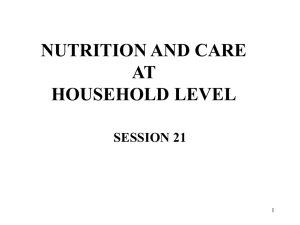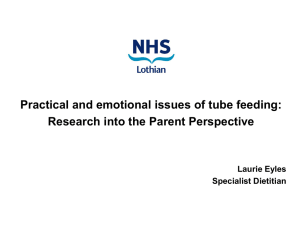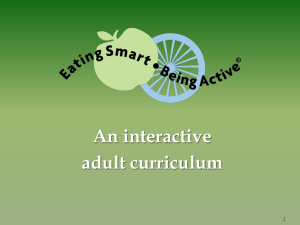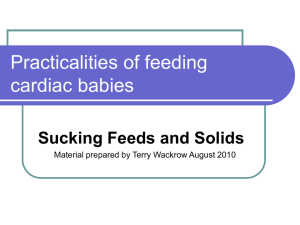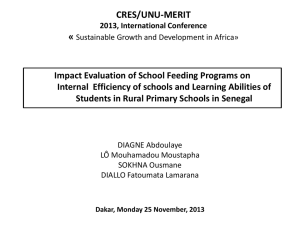Less is more: the key to a positive feeding experience
advertisement
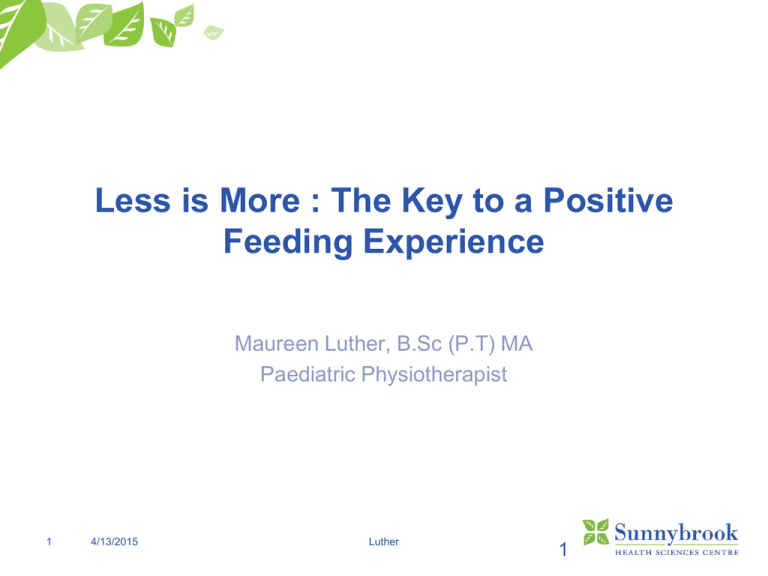
Less is More : The Key to a Positive Feeding Experience Maureen Luther, B.Sc (P.T) MA Paediatric Physiotherapist 1 4/13/2015 Luther 1 Objectives 1.Discuss the implementation of developmentally supportive feeding interventions within the NICU 2.Evaluate the theoretical framework that guides cue based feeding and use this framework to maximize feeding potential of the preterm infant 3.Discuss the long term ramifications of negative feeding experiences and the interventions utilized by the Neonatal Follow-up clinic 2 4/13/2015 Luther Goals of Developmentally Supportive Care in the NICU NICU intervention Strategies for the infant focuses on stress reduction (Als, H, 1982) • Evidence is accumulating that stress during early human ontogeny is also associated with long-term modifications of neurobehavioural development • Sensitivity of the young nervous system to stress-related factors implies that reduction of stress is an important goal of early intervention before term age. (Hadders-Algra,2011) 3 Neurodevelopmental processes during human ontogeny (De Graaf-Peters & Hadders-Algra, Early Hum Dev 2006; 82: 257-66 4 Goals of Developmentally Supportive Care in the NICU • Facilitate responsive parenting “ sensitive to their infants cues and have the ability and knowledge to alleviate infant’s stress” ( NCAST, 1994) • Foster positive parent- child relationship -attachment fostered by the mother/infant dyad learning about each other -disrupted for preterm infants “Vulnerable to forming lower-quality attachment to caregiver due to disruption of early experiences and separation” ( Sullivan et al, 2011) 5 Goals of Developmentally Supportive “Feeding” Care • Oral feeding - interactive, developmental task (Thoyre and Brown, 2004) - the most complex and highly co-ordinated sensorimotor mode of oral feeding - requires appropriate oral motor development and function with neurological maturation - is dependent on the mother / child interaction - feeding needs to be a pleasant, relaxed and a controlled experience 6 Understanding Oral Motor Development for Successful Feeding • • Somatesthetic (Tactile) Development First sense to develop: 8weeks – the perioral area 10 weeks - palms of hands, plantar surface of feet 11 weeks - entire face • • • 7 Sensation of pressure, pain, and temperature Protective mechanism Provides information through which neurodevelopment and cognition is enriched Understanding Oral Motor Development for Successful Feeding • Taste cells: form at 7-8 weeks GA, functionally mature by 17 weeks • Fetal swallowing – begins at 12 weeks GA • Rhythmical bursts of jaw opening and closing - 14 weeks GA • Non Nutritive Sucking – 18 weeks GA • Safe, effective Swallow -32 weeks GA • Coordinated sucking and swallowing – by 35 to 40 weeks (Lipchock et al, 2012, Brown,J & Ross, E, 2011) 8 Medical issues affecting feeding • Hypotonia - related to GA, BW, Severity of illness • Respiratory:Bronchopulmonary Dysplasia (BPD): contributes to poor SSB coordination significant increases in deglutition apnea poor sucking endurance and performance ( Gewolb,IR & Vice, FL 2006, Mizuno,K et al, 2007) • Neurological Dysfunctional suck– may exclude breastfeeding (NOMAS, Palmer,M 1992) 9 NICU: Positive Feeding Strategies • Developmentally supportive environment during the feeding process: -appropriate lighting -sound levels within the unit • Primary Nursing Care: - essential to consistency and relationship building - cluster of non-emergent care 10 NICU: Positive Feeding Strategies • Positioning : a positive oral experience - Flexion – sucking is a flexion activity - Midline – hands to mouth - Promoting comfort and sleep • Non Nutritive Sucking: -provides comfort and self-soothing ( Pinelli and Symington, 2010) 11 NICU: Positive Feeding Strategies • Stressful procedures: Are we providing support and comfort? • Opportunities for a positive oral experience Ventilation Procedures: Diaper change , vital signs Bolus feeds “ Tube fed infants increase NNS when exposed to smell of Expressed Breast Milk which suggests this may assist in transition to oral feeding” (Lipchock SV et al , 2011) 12 NICU: Positive Feeding Strategies Pain Management : • Negative oral experiences: are they painful? - Taping - Suctioning - Placement of OG/NG tubes - Intubations • Use of pharmacological and non-pharmacological pain management strategies 13 NICU: Positive Feeding Strategies • Skin to Skin Care • Infant Benefits: – Improved physiological stability – More organized sleep wake cycles (Ludington Hoe,S 2006) – Decreased nosocomial infections – Non-pharmacological pain management strategy (AAP, 2006, Johnston,C et al, 2003, 2008) • Parent Benefits: – Improved breastfeeding duration and milk production – Improved attachment – Increased confidence (Johnson, AN. 2007) 14 “Kangaroo care is crucial for babies to grow and develop and is also medicine for the souls of parents.” quote from parent during our Kangaroo-a-thon 15 NICU: Positive Feeding Strategies • Cue-based feeding – Quality versus Quantity? - a positive feeding experience for the infant - a developmental process that requires support from moment to moment ( Shaker, CS 2012) • Need to move away from the viewpoint that a successful feed is based on numbers ( Ross,E & Philbin,K 2011) 16 NICU: Positive Feeding Strategies • A successful Cue-Based Feeding involves: • Infant - physiologically stable - actively participating - self regulated - comfortable • Caregiver - sensitive to infants cues – state and physiologic - responds appropriately to cues - competent feeding skills (Ross,E & Philbin K, 2011) 17 NICU: Positive Feeding Strategies: Understanding the Infant’s Cues Stress Cues: Vital Signs: RR, HR, O2 sat Respiratory: increased WOB Visceral: gagging, vomiting State : rapid state change Sensory: facial/ gaze aversion Oral Motor: uncoordinated SSB Motor: head turning, extension, increased limb movement (NOMAS,1993,2002) 18 NICU: Positive Feeding Strategies: Understanding the Infant’s Cues Stability Cues • Vital Signs: stable RR 40-60 • Respiratory: pause = burst • State regulation • Oral Motor: rooting, coordinated SSB • Motor: gentle forward flexion • 19 Hunger and satiation cues 4/13/2015 Luther NICU: Positive Feeding Strategies: Understanding the Infant’s Cues Consequences of not responding to stress cues: • • • • • • • • 20 Compromise physiological stability Loss of state regulation and postural control Stress++ Possible Laryngeal penetration/ aspiration Eventually Feeding Refusal Behaviour/ Feeding Aversion Altered Brain Development Altered parent/infant attachment NICU: Positive Feeding Strategies Feeding Readiness: • Begins with physiologic stability “ stable vital signs, good colour, and good muscle tone when the infant is alone in the bed or during simple handling “( Ross,E & Philbin,K, 2011) • Infant begins to show signs of hunger • Infant can maintain physiologic stability and a drowsy or alert state while being held with NNS ( Ross,E & Philbin,K, 2011) 21 Feeding Readiness® Scale (Ludwig and Waitzman 2007) If scores 1 or 2 – can attempt to orally feed If scores 3-5 – do not attempt to orally feed 1) Alert or fussy prior to care. Rooting and/or hands to mouth behavior. Good tone. 2) Alert once handled. Some rooting or takes pacifier. Adequate tone. 3) Briefly alert with care. No hunger behaviors (i.e. rooting, sucking). Adequate tone. 4) Sleeping throughout care. No hunger cues. No change in tone. 5) Significant HR, RR , 02, or WOB outside of baseline HR <100 bpm, RR > 60 bpm , SaO2 <80 % WOB=nasal flaring, tracheal tugging Action: Stop feeding, reassess, if scores 1-2 and physiologically returns to baseline, retry once more 22 NICU: Positive Feeding Strategies Breastfeeding • Physiologically easier “infants with BPD who were breastfed were found to have higher O2 saturations during feeding than bottle feeding” ( Mizuno et al, 2007) • Baby active participant, mother is supportive 23 NICU: Positive Feeding Strategies Bottle feeding • An appropriate feeding alternative -can be physically easier -with cue based feeding the feeder needs to be carefully watching the infant and taking his lead -infant is a co-regulatory partner in the feeding process (Shaker,C 2013) 24 NICU: Positive Feeding Strategies Bottle feeding • Goals: • Safety: prevent aspiration, physiologic instability, excessive fatigue • Functional : adequate volumes for growth without undue stress to infant • Relationship based – nurturing – infant and parent – should be pleasant for both • Individual and developmentally supportive (Ludwig and Waitzman, 2007) 25 NICU: Positive Feeding Strategies: Responding to cues • Feeding continues if infant maintains strong coordinated suck • Allow for opportunities for “catch up” breathing AVOID PASSIVE MANIPULATION OF THE NIPPLE 26 NICU: Positive Feeding Strategies: Responding to cues • Respond to disengagement/stress cues STOP FEEDING “Feeding is stopped when infant communicates that he is done or the inability to continue for whatever reason NOT just when the bottle is empty/volume driven” ( Shaker,CS 2013) • Intake is a byproduct of a quality feeding interaction and within the context of the emerging feeding skills 27 4/13/2015 Luther NICU: Positive Feeding Strategies: Providing individualized support External pacing: a method of providing external control of the infant’s SSB ( Palmer,M 1993,Philbin&Ross, 2011) -Assists infant’s physiologic stability -Prevents the formation of maladaptive, oromotor problems -Increases infant’s comfort with feeding -Assists an appropriate intake volume 28 NICU: Positive Feeding Strategies: Providing individualized support External Pacing: Need to be anticipatory and preventative start with horizontal bottle count the Sucks and Swallows ( allow 3-5) if followed by breathe, allow pause if no breathe, tip bottle down, keep nipple in mouth Signs to pace – raising eyebrows*, nasal flaring, eyes widening, pulling back ( Ludwig, SM & Waitzman, KA 2007) 29 NICU: Positive Feeding Strategies: Providing individualized support Postural Control: supportive swaddling with a blanket ( Wolf L & Glass,R 1992) “hand swaddling ” control with hands ( Philbin &Ross, 2011) by grasping hand – promotes flexion 30 NICU: Positive Feeding Strategies: Providing individualized support Positioning - good alignment for best function - promoting attachment enface “the position in which the caregiver’s face is rotated so that the eyes and those of the child’s can meet fully in the same vertical plane of rotation” (NCAST, 1994) No difference in semi reclined vs upright vs elevated side lying positioning in improving oral feeding skills ( Lau,C 2013) 31 NICU: Positive Feeding Strategies: Providing individualized support • Appropriate Nipple selection: • Consistency of liquid: to thicken or not? • Therapeutic techniques: When are they really necessary? Jaw support Jaw and cheek support 32 NICU: Positive Feeding Strategies Feeding Plan: -consistency is critical -communication of the plan -need to reduce variation – interferes with learning to feed - plan needs to be developed by the various members of the team including the parent 33 NICU: Positive Feeding Strategies Fostering parent /child relationship • Start early to include parents in the care of their infants • Modeling • Coaching • Anticipatory Guidance 34 NICU: Positive Feeding Strategies Fostering parent /child relationship Goals of the NICU caregiver: -Facilitate the parent/ child relationship by promoting a co-regulated feeding approach - Foster confident and competent parents 35 NICU: Positive Feeding Strategies Fostering parent /child relationship Understanding the stressors for the parents: • • Inconsistent information Excluded from the feeding plan and changes in the plan Respecting the parents choice – breast or bottle Not watching the baby’s cues Feeding should be a joyful experience Feeding – “this is the worst” – when baby not feeding Parent really feels like a bad parent • • • • • 36 NICU: Positive Feeding Strategies Preparing for Discharge Successful and safe feeding often delays discharge ( Shaker, CS, 2012, Lau C, 2003) Goals: • Parent - confident and competent • Infant: medically stable a safe feeding plan supports growth and nutrition promotes positive parental interaction 37 NICU: Positive Feeding Strategies Avoiding Feeding difficulties/problems • Absence of early ( normal) postnatal chemosensory experiences , disruption in maternal attachment and negative associations with early feeding experiences contribute to future feeding difficulties (Lipchock, SV et al, 2011) • Strong association between feeding and discomfort ( including struggling to breathe and reflux) can develop an aversion to feeding (Philbin & Ross, 2011) • Most infants who develop feeding problems are averse to food and feeding (Ross,E and Philbin,K 2011) 38 Neonatal Follow-up: Early Intervention Feeding issues in the first year • Higher incidence of early regulatory disorders ( excessive crying, sleeping difficulties and/or feeding problems) in preterm infant (Arpi E, Ferrari F. 2013) • Crying, feeding and sleeping problems has a correlation with poor cognitive outcome and behavioural problems (Wolke,2009 ) • Regulatory problems in infancy can increase the likelihood of developing behavioral problems in childhood (Hemmi MH et al, 2011) • By school age, ELBW children have a greater risk to have eating problems ( Samara M et al, 2009) 39 Neonatal Follow-up: Early Intervention • First 6 months: Feeding De – medicalize feeding • Feeding : 3 pronged approach – Growth & nutrition – Age appropriate oral motor skill, positioning and assist in transitions – Positive Maternal /child feeding interaction ( Arvedson, J. 2002 ) • Address GERD - criteria for intervention and management 40 Neonatal Follow-up: Early Intervention • 6-12 months: Feeding to “Eating” • Expanding texture acquisition • Decreasing fluid intake • New utensils • Proper seating • Mealtime rules and routines ( Chatoor et al, 1997 and DeGangi, G, 2000) • Self-feeding • Social activity 41 Conclusion: Less is More Less: • Emphasis on quantity of feed • Stress during feeding 42 More • Skin to Skin • Emphasis on quality of feed • Cue based feeding • Parental input
